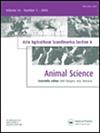挪威和瑞典峡湾马种群内部和之间的共同祖先、加性关系和遗传变异
IF 0.9
4区 农林科学
Q3 AGRICULTURE, DAIRY & ANIMAL SCIENCE
Acta Agriculturae Scandinavica Section A-Animal Science
Pub Date : 2020-02-04
DOI:10.1080/09064702.2019.1711155
引用次数: 2
摘要
峡湾马起源于挪威,但由于在国外有几个小种群,因此形成了一个全球种群。这些亚群之间的加性关系和遗传变异尚无相关资料。通过收集挪威和瑞典峡湾马的血液样本,311匹挪威马和102匹瑞典马的样本提供了485,918个可供分析的snp。计算近交系数,并与两两共祖先和共享基因组片段进行比较。在挪威峡湾马种群(63和71)中,有效种群大小与两种方法几乎相似,但在瑞典种群(269和1136)中差异很大,并且由于观察数量少得多而不精确。该研究表明,来自共享基因组片段的共祖先可用于估计全球峡湾马种群内部和之间的加性遗传关系和遗传变异。本文章由计算机程序翻译,如有差异,请以英文原文为准。
Segment-based coancestry, additive relationship and genetic variance within and between the Norwegian and the Swedish Fjord horse populations
ABSTRACT The Fjord horse originates from Norway but forms a global population due to several small populations in foreign countries. There exists no information about the additive relationship and the genetic variance between these subpopulations. By collecting blood samples from Norwegian and Swedish Fjord horses, a sample of 311 Norwegian and 102 Swedish horses gave 485,918 SNPs available for analysis. Their inbreeding coefficients were calculated and compared to the pairwise coancestry and the shared genomic segments. The effective population size was almost similar with the two methods in the Norwegian Fjord horse population (63 and 71), but very different in the Swedish population (269 and 1136) and unprecise due to a much smaller number of observations. The study showed that coancestry from shared genomic segments can be used to estimate additive genetic relationship and genetic variation within and between the global populations of the Fjord horse.
求助全文
通过发布文献求助,成功后即可免费获取论文全文。
去求助
来源期刊

Acta Agriculturae Scandinavica Section A-Animal Science
农林科学-奶制品与动物科学
CiteScore
2.30
自引率
0.00%
发文量
9
审稿时长
>36 weeks
期刊介绍:
Acta Agriculturæ Scandinavica, Section A – Animal Science publishes results of original research in animal science and their applications related to the following topics:
-Animal breeding and genetics
-Molecular genetics
-Animal physiology and reproduction
-Nutrition and feeding
-Animal behaviour and welfare
-General animal husbandry and systems of production, including economic and technical aspects
-Hygiene and quality of animal products
In addition to original articles, covering basic as well as applied subjects, the journal features review articles and short communications.
Acta Agriculturæ Scandinavica, Section A – Animal Science forms part of a trilogy of titles published on behalf of the Nordic Association of Agricultural Scientists (NJF). The series also includes Section B - Soil & Plant Science and the recently launched Section C - Food Economics .
Acta Agriculturae Scandinavica A, B and C are available to purchase as a combined subscription. This provides access to all three journals in the series, and is available to institutional subscribers only. For full pricing information, please view the Taylor & Francis Journals Price List here.
Scientists in research, teaching and extension with specialised interest in animal science and production.
 求助内容:
求助内容: 应助结果提醒方式:
应助结果提醒方式:


